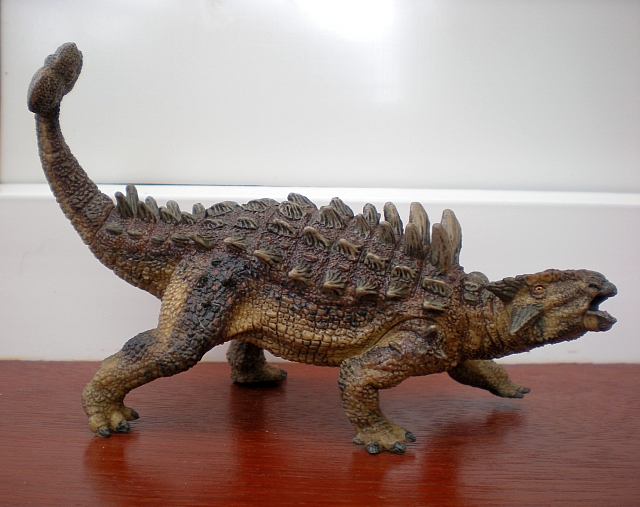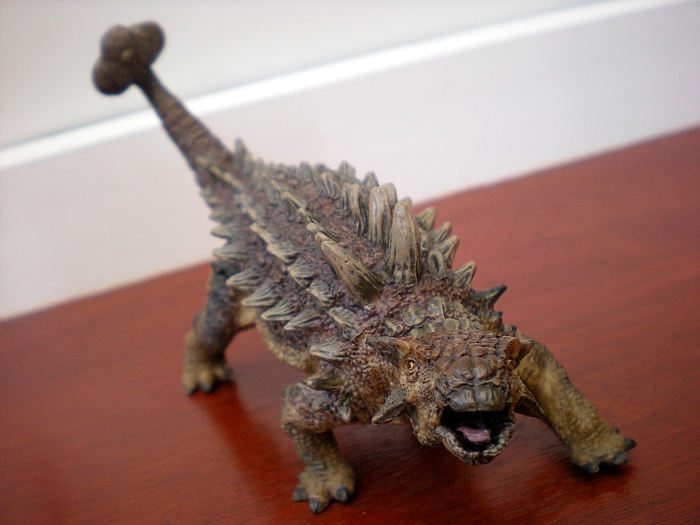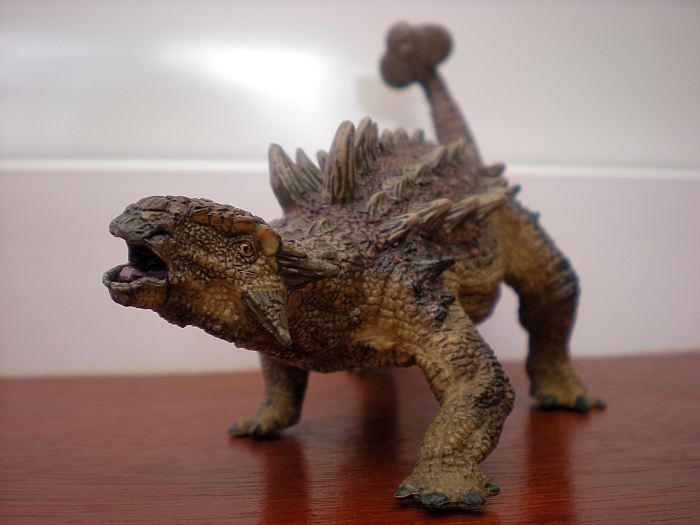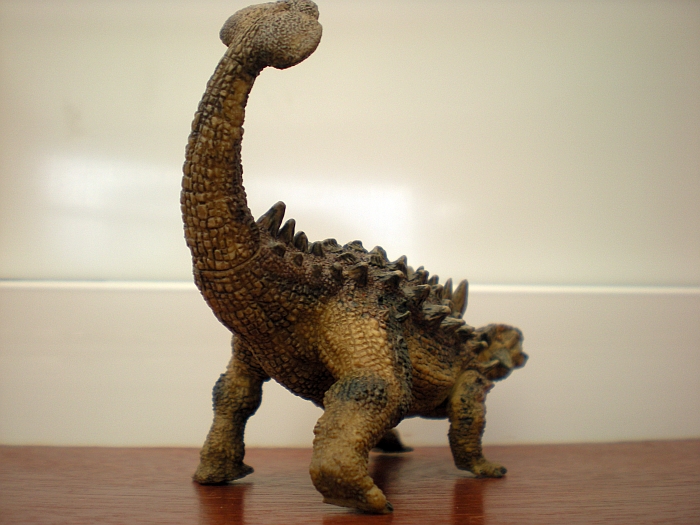First things first – this is yet another “Ankylosaurus” model that is nothing of the sort, instead rather obviously being based on Euoplocephalus (would giving these figures the correct name really harm their commercial prospects that much?). It’s also Papo’s very latest dinosaur, released a few months ago and well overdue the Dinosaur Toy Blog treatment.

Papo’s legions of screaming fans (maybe) will be pleased to know that this figure continues the company’s tradition of preposterous detailing and immaculate paint schemes, the likes of which have often made other manufacturers’ efforts look plain embarrassing. A few may complain that it’s a little on the brown side, but it’s still one of the few dinosaur toys that one can use the word ‘sumptuous’ about with a straight face. Every fine detail – scutes and spikes, eyes, tongue – is painted flawlessly. In terms of aesthetics, Papo remain without peer at this price point, and the careful paintwork even puts some expensive resin models to shame.

The pose is an interesting one. Thanks mostly to their bulky, squat frame, the majority of ankylosaur figures tend to have fairly similar poses – just standing or walking with the tail swinging out to one side. However, Papo’s “Ankylosaurus” is posed crouching, as if to brace itself, with its tail swinging wildly up into the air. Such an inventive, exciting pose is definitely worthy of commendation, and really makes the toy stand out among its more static peers. Being frozen in such a pose may limit its playability for kids, but there’s no doubt that any dino-mad child (or man-child, ahem) would be thrilled to receive a figure like this anyway.

Anatomically there are certainly flaws, as usual, although this is far from being the most severely flawed figure in the Papo range (dare I mention the horrible Oviraptor again?). Apart from it being a Euoplocephalus rather than an Ankylosaurus, the head is too large for the body, and the tail rather too short. Most significantly though, the body fails to reflect the true nature of ankylosaur anatomy, that is to say incredibly wide-hipped and strange. The similarly mislabelled Favorite “Ankylosaurus“ shows how it should be done, even if it is not quite as lovely to look at.

Still – and speaking as someone who has gained a bit of a reputation for nitpicking – this is not a figure that should be passed up (or destroyed on sight, like the Oviraptor). In spite of the anatomical errors this is a beautifully made plastic dinosaur at a very reasonable price, and I highly recommend it. Now if only Papo would consult with palaeontologists when developing their figures – THEN we would have hands-down the best dinosaur toy range in the world. One can but dream…
Available from eBay stores here
Disclaimer: links to Ebay and Amazon on the DinoToyBlog are affiliate links, so we make a small commission if you use them. Thanks for supporting us!




Faját tekintve viszont egyértelműen
egy Euoplocephalus.
Én egyetértek Dino-myttel.
Valóban elképzelhető,hogy rugalmasabb volt a farka mint
gondoljuk.Illetve a Papp célja leginkább az,hogy figuráikkal lenyűgözzék az embereket,és ez sikerült is nekik.Persze még így is vannak kirívóó kivételek.Pl.:érthetelen Oviraptor(tudommeg lett már említve),a “a háromlábú”T-rex,a hátraesni készülő Giganotosaurus.
Ezek szerintem a legrosszabbak.
A kedvenc Paposom a Megaloceros.
[…] Up today is the first ankylosaur that Geoworld ever released for their line. Euoplocephalus was once the go-to ankylosaur for toy companies in the 90s’ due to the fact that it was a better known species then its family’s namesake. However, over the years, it seems to have been phased out in favour of Ankylosaurus, even if the toy still ends up looking like a Euoplocephalus anyway. […]
[…] fossil specimens. Indeed, many popular depictions of Ankylosaurus in books, movies, and yes, toy lines, are actually based on […]
[…] brand new Ankylosaurus someday. On the other hand, this toy is still closer to the real thing than certain others. And the sheer size, durability, funky colours, and fearsome appearance of this toy make it […]
@Dino-myte!!: As Victoria mentioned in her comment, in ankylosaurids, it’s only the last half of the tail that’s stiff and straight. Like the handle in an axe. We know this is true because in ankylosaurids the vertebrae in the last half of the tail overlap each other or are fused together. The front half (tail base) is flexible to a degree, which is where tail swinging would come from.
It makes sense. The last half of the tail needs to be stiff to support the weight of the tail knob. To me it also seems that if ankylosaurids had fully flexible tails, like on the Papo Ankylosaurus, they wouldn’t be able to transmit as much force in a strike from their tail as the real animals with the stiff tail club handle could.
Ankylosaurid tails seem to have evolved to be as effective weapons as they could be, focusing on side tail swinging to strike the parts of predators that are most vulnerable and important to movement, the fragile lower leg bones.
More about this can be seen here: http://blog.everythingdinosaur.co.uk/blog/_archives/2015/09/04/a-tale-of-ancient-tails-in-the-ankylosauridae.html
@Sim, I got your explanation. Lower side swings are more plausible, since most predators are bipedal and therefore, more vulnerable in their hind limbs. As long as their tail clubs can be swung to certain degree, ankylosaurs will sometimes be immortalized in plastic this way.
Once again, Papo brings me to another deja’ vu, like “Now, where have I seen this before?” Ah, I got it!! Disney’s ‘Dinosaur’ movie! Bayleen’s pet Ankylosaurus. I forgot his name, but this figure reminds of him. I’m not sure what this model is, but if that’s what Papo wants to deliver, so be it. All the tiniest details are here. The colors are typical Papo, nothing flashy, just natural.
I’d like to see this model to be a big larger, but it’s acceptable enough for its scale. As for the battle stance, it’s a given. This is one herbivore who’s tired of running scared.
The only battle stance this figure has is one where its tail is being broken. (See Victoria’s comment for an explanation.)
Jeez, I hope not. After all, it’s just a model. Battle stance or not, it’s still a nice figure. I prefer to keep my ankylosaur’s tail intact.
In one way, the Papo Ankylosaurus’s tail is like that of tail-dragging Iguanodon. In both, the tail has to be literally broken to achieve the pose.
Something very interesting is some early ankylosaurids have tails that are stiff but don’t have a tail club, which suggests that in ankylosaurids the tail evolved first to be a stiff appendage and later the tail club evolved.
So what good is a stiff tail when you can’t swing it to use the club? Come on, Sim. Let’s be a little optimistic here. I’m sure when the ankylosaurs developed a tail club, their tails would’ve evolved with tendons flexible enough to wield the bony club. After all, it’s all in theory when it comes to dinosaurs.
[…] familiar to some of you? Well, that’s because it’s virtually identical to that of the Papo Ankylosaurus. Indeed, this toy looks and feels like a bigger, cheaper […]
I got this a while ago and putting aside all the anatomical flaws with the contorted tail, I still like the pose on this, I know deep down I shouldn’t, but I’m kinda bored of seeing the same old glum looking waddling boulder of an Ankylosaurid. This figure really brings the animal to life for me, and instead of seeing a dim-witted bulk, I see…. an ANIMAL! Maybe Papo have made a few mistakes here, but I think we should allow just a teeny bit of creative license for this, as it is worth it for the sake of a figure with such a dynamic posture. It looks lean and mean.
The paintwork is also truly remarkable!
I just wished they hadn’t referred to it as an “Ankylosaurus” though, I’m just glad in this case that Papo haven’t labelled the figure with the name (this usually annoys me a bit, as many other companies label their figures and give some basic facts etc, which is always nice for a collection, but in this case I’m willing to let that go as I wouldn’t want the wrong name printed on it – so I can be free to call it a Euoplocephalus).
Papo comete siempre el mismo error,y es una lástima porque sus creaciones son siempre espectaculares y detalladas al máximo.Las posturas son tambien muy dinámicas,superando incluso a otras marcas más afamadas.La pena es que les falta rigor científico y no se ajustan a criterios paleontológicos.Este fallo es constatable,como ya se ha apuntado,en el caso de Oviraptor y también en Velocirraptor.Lástima porque hay que reconocer que es una figura muy atractiva.
@Victoria: I had a feeling that that might be true, but I went with my initial childlike reaction of “AWESOME POSE!!1!” (I really need to read more about ankylosaurs). No doubt such a feature is just as offensive to an ankylosaur expert as a scaly Oviraptor would be to a theropod fan.
Aparte de todas las apreciaciones que han hecho los presentes también veo un fallo en este Ankylosaurus, su posición con la cola tan erecta me recuerda mas que a un ankylosaurus a un escorpión en posición de ataque, aparte de esto la figura no es a mi entender de las mejores de ankylosaurus me quedo con la de la serie Walking With Dinosaurs de la serie BBC
Papo should return making theropods…they’re more charming
Although I love the look of the figure, I must disagree with your commendation on the tail-up pose. The last half of an ankylosaurid’s tail is formed of interlocking, sometimes fused vertebrae, which would render it stiff and straight. This model’s tail is curved and therefore, if it were a real animal, it’s open-mouth expression would probably reflect shock and pain at the trauma to the tail! It is also highly unlikely that the tail could be raised to that height. Sadly, the tail club knob is also hugely inaccurate, which is a shame because there is a very nice tail club known for Ankylosaurus and it is easy to find pictures of since it’s on display at the American Museum of Natural History. I’d still probably buy one, but it’s a shame it’s not just a smidge more accurate because they’d have a really superb model if it were!
Harrrumph. I’m NOT seeing a cloacal opening in that last image.